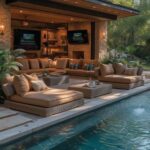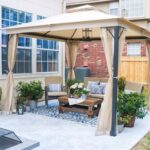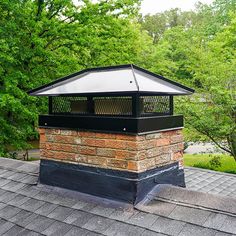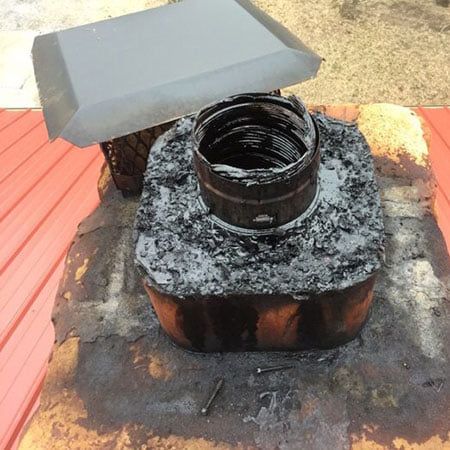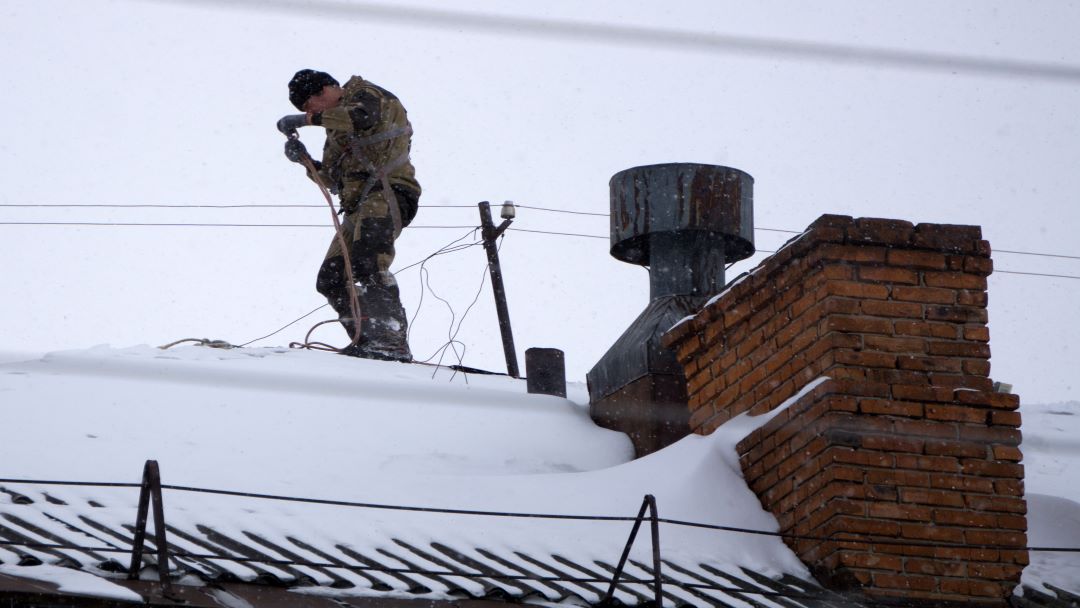Are Chimney Caps a Good Idea? The answer is yes, chimney caps are an important part of any chimney system. They provide multiple benefits that help protect your chimney, home, and family. However, like most things, chimney caps also come with some potential downsides. This article will examine the pros and cons of chimney caps to help you determine if installing one is the right decision for your home.
What is a Chimney Cap?
A chimney cap is a covering installed on top of the chimney opening. It is usually made of metal or concrete.
Chimney caps have several purposes:
- Chimney cap prevents rain, snow, animals, leaves, and other debris from falling into the chimney.
- Chimney cap screens help prevent sparks from escaping through the top of the chimney.
- Chimney cap can help reduce downdrafts coming down the chimney.
The Pros of Installing a Chimney Cap
Chimney caps provide many benefits that help protect your chimney, home, and family. Here are some of the main pros of installing a chimney cap:
Prevents Water Damage
Water is one of the biggest threats to your chimney. When water gets inside the chimney, it can cause damage to the brick and mortar. This can accelerate deterioration and cracking. Water inside the chimney system can also leak into the home, causing interior water damage.
A chimney cap prevents rain and melting snow from entering the chimney. This helps stop water damage to the chimney and potential leaking into the home. A chimney cap helps extend the life of your chimney.
‘If there is no chimney cap, the rain pours in and can cause damage to your attic and interior ceilings and walls. If a chimney cap has mesh siding, it can prevent critters from getting into your chimney and causing a variety of problems and inconveniences.’
https://www.chimneysolutions.com/blog/prevent-problems-chimney-cap/
Stops Animals, Debris, and Drafts
Raccoons, birds, leaves, branches, and other debris can fall down an open chimney. Their presence inside the chimney can lead to clogs and blockages.
Some animals may get trapped inside the chimney and die. This can create awful odors inside the home.
A chimney cap uses wire mesh screening to prevent debris and animals from falling inside. This helps keep the chimney clear for proper drafting.
Additionally, a chimney cap can reduce downdrafts of cold air coming down the chimney. This improves the draft and performance of your fireplace or stove. It also prevents cold drafts from entering the home.
Contains Sparks and Embers
Burning wood in a fireplace or stove produces flying embers and sparks. These glowing embers may escape out of an uncapped chimney. This poses a fire hazard, especially during dry conditions.
A chimney cap uses wire mesh to contain embers and sparks. This prevents them from landing on the roof or nearby trees, plants, or structures. Containing the embers and sparks is a critical fire safety benefit.
Improves Aesthetics
A professionally installed chimney cap can be an attractive architectural feature on the roof. Stainless steel and copper caps can enhance the overall aesthetics and home value.
Chimney cap styles are available to match different home architecture and preferences. This includes pyramid caps, arched caps, and flat caps.
Low Maintenance
A chimney cap requires little maintenance as long as it is inspected annually and cleaned as needed. During a professional chimney cleaning, the chimney technician will inspect the cap and remove any built-up creosote or debris clogging the mesh screen.
Proper chimney maintenance helps ensure your chimney cap continues working as intended for years to come.
The Cons of Chimney Caps
While chimney caps provide substantial protection and benefits, there can also be some drawbacks in certain situations. Here are a few potential cons to consider when deciding on a chimney cap:
Can Clog with Creosote and Soot
Burning wood leads to the buildup of creosote and soot inside the chimney. Some of this combustion residue can clog the wire mesh screen on the chimney cap.
When the screen becomes clogged, it reduces airflow. This airflow reduction chokes the fire of oxygen, leading to poor performance and drafting.
Annual chimney cleanings are recommended to prevent the chimney cap mesh from becoming clogged with creosote, soot, and ash buildup.
Prone to Clogs from Debris
Outdoor debris such as leaves, seeds, twigs, and other refuse can clog the chimney cap mesh screen. Nearby trees increase the amount of debris that can accumulate.
Clogs from debris also reduce airflow and draft performance. Proper chimney maintenance helps keep the cap clear of obstructions.
Can Freeze Over in Cold Climates
In frigid winter conditions, snow and ice may freeze over the chimney cap mesh screen. This results in choked airflow and poor draft performance.
It is recommended to visually inspect the chimney cap after heavy snowfalls to check for ice dams. Removing snow and ice dams helps maintain proper airflow.
Installing a chimney cap with a larger surface area can also help reduce freezing in cold climates.
Adds Cost to Chimney Construction
Chimney caps range from $100 on the low end to $500+ for large custom caps. Having a masonry contractor install a chimney cap adds cost to the initial chimney construction budget.
However, this added cost may be worth the long-term protection and benefits provided by a proper chimney cap.
Can Increase Chimney Draft Too Much
In rare cases, adding a chimney cap increases draft strength to the point that the fire burns too hot. This is more likely with newer stoves and fireplaces that already provide substantial draft.
If a chimney cap results in over-firing of the stove or fireplace, a damper disc can be installed in the cap to limit excess draft.
Important Chimney Cap Features
Chimney caps are available in different shapes, sizes, materials, and features. Here are the key features to look for when selecting a chimney cap:
- Mesh screening – Stainless steel mesh screening prevents sparks, embers, animals and debris from entering chimney
- Full coverage – Cap should completely cover chimney opening to prevent water entry
- Durable material – Stainless steel, copper, galvanized steel are suitable materials
- Easy installation – Choose a chimney cap that masons can properly install on your chimney
- Spark arrestor – Mesh screen should meet spark arrestor testing standards
- Freeze-proof – Larger surface area helps prevent freezing and ice dams
Chimney cap size should match your chimney crown opening for proper coverage and installation.
Chimney Cap Maintenance Tips
While chimney caps are relatively low maintenance, you need to perform periodic inspections and cleaning to keep them working properly:
- Conduct visual inspections of the chimney cap when cleaning the gutters or roof. Check for any damages, cracks, or mesh blockages
- Have a professional chimney sweep clean and inspect the cap during periodic chimney cleanings. They will clear any creosote or debris clogs.
- Use a wire brush and scraper to gently remove any debris or buildup from the chimney cap mesh screen after inspection
- Check chimney cap after heavy storms for any damage or displacement. Repair any damages immediately to prevent leaks or animals entering the chimney.
- Remove snow, ice or tree debris that has accumulated on the chimney cap. This helps maintain proper chimney drafting.
- Replace the chimney cap if it shows major rusting, damage, or deterioration. A new cap will ensure it keeps protecting your chimney.
Finding the Right Chimney Cap
If you need a new chimney cap installed or want to replace an existing cap, make sure to get the right cap for your chimney:
- Have a professional chimney mason or installer measure your chimney crown opening so you get the right sized cap
- Choose a cap material and style that fits your chimney design and matches your home
- Look for a chimney cap brand known for quality and durability such as Olympia Chimney Supply
- Work with an experienced masonry contractor or chimney specialist to install the chimney cap properly
- Ask your chimney pro about getting a custom chimney cap if you need a special size or design
- Budget approximately $250 to $500 for a professionally installed chimney cap
Investing in a high quality chimney cap that is properly installed will provide lasting protection and performance.
Conclusion
Adding a chimney cap provides valuable benefits that help protect your chimney, home, and family. It prevents water entry, stops animals and debris from falling in, and contains dangerous embers and sparks.
While chimney caps can become clogged over time, having annual professional chimney cleanings helps keep the cap clear and functioning properly. The pros of protecting your chimney typically outweigh any cons from occasional clogs or added cost.
Overall, installing a chimney cap is a good idea for most homeowners with a wood burning chimney. Be sure to choose the right style and material for your home and have it installed properly by a chimney pro. Perform periodic maintenance and cleaning to keep your chimney cap working effectively for years to come.


